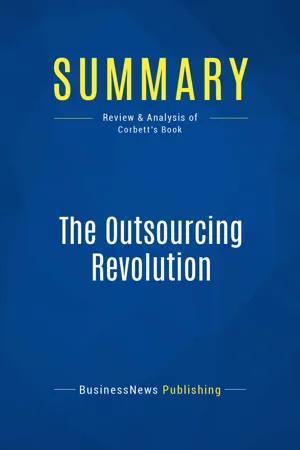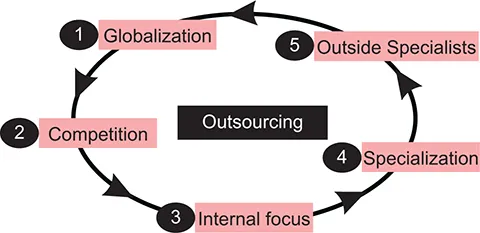
Summary: The Outsourcing Revolution
Review and Analysis of Corbett's Book
- English
- ePUB (mobile friendly)
- Available on iOS & Android
About this book
The must-read summary of Michael Corbett's book: `The Outsourcing Revolution: Why It Makes Sense and How to Do It Right`.
This complete summary of the ideas from Michael Corbett's book `The Outsourcing Revolution` deals with a highly controversial topic. Outsourcing tends to get blamed whenever jobs move from one country to another. However, outsourcing is currently a $6 trillion global industry, and within the next decade will grow appreciably as more and more organisations transform their operations to take advantage of everything outsourcing offers. In his book, the author explains how outsourcing helps make companies more productive and more competitive in the global marketplace and provides benefits for your business that should not be ignored. This summary is a must-read for anyone who wants to know more about the outsourcing process that will shape the world of tomorrow.
Added-value of this summary:
• Save time
• Understand key concepts
• Expand your knowledge
To learn more, read `The Outsourcing Revolution` and discover the benefits of outsourcing and why you shouldn't ignore it.
Frequently asked questions
- Essential is ideal for learners and professionals who enjoy exploring a wide range of subjects. Access the Essential Library with 800,000+ trusted titles and best-sellers across business, personal growth, and the humanities. Includes unlimited reading time and Standard Read Aloud voice.
- Complete: Perfect for advanced learners and researchers needing full, unrestricted access. Unlock 1.4M+ books across hundreds of subjects, including academic and specialized titles. The Complete Plan also includes advanced features like Premium Read Aloud and Research Assistant.
Please note we cannot support devices running on iOS 13 and Android 7 or earlier. Learn more about using the app.
Information
Summary of The Outsourcing Revolution (Michael Corbett)
1. Where outsourcing is today

- Service providers build their capabilities to such a high degree of performance that they are progressively more superior to anything a firm can provide for itself.
- Technology means the service provider can be located anywhere and deliver products and services electronically.
- The risk of investing in state-of-the-art technology shifts from the firm itself to the outside service provider who needs to stay at the cutting edge to remain competitive.
- A firm must be able to perform a business processes better and cheaper than both its direct competitors and the best outsourcing service providers available. Otherwise, it risks handing an operational competitive advantage to its competitors who are able to use the best of breed.
- To reduce costs (49-percent of respondents)
- To improve the firm’s own focus (17-percent)
- To access a variable cost structure (12-percent)
- To access additional skills and expertise (9-percent)
- To grow revenue (4-percent)
- To improve quality (3-percent)
- To conserve capital (3-percent)
- To become more innovative (3-percent).
- Each department reports to a manager.
- The departments are grouped together into business units along geographical or functional lines.
- The managers of the various departments and business units report to executives who then report to the CEO.
- There must be an understanding of what customers want and a commitment to deliver precisely that.
- There must be no barriers between what is done internally and what’s carried out by service providers.
- There must be a drive to work with service providers to achieve scale and efficiency.
- There must be a commitment to create more customer value by offering lower prices, new revenue streams or even entirely new business ventures.
Table of contents
- Title page
- Book Presentation
- Summary of The Outsourcing Revolution (Michael Corbett)
- About the Summary Publisher
- Copyright